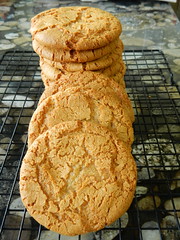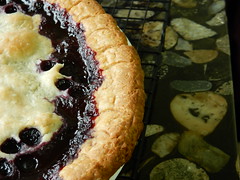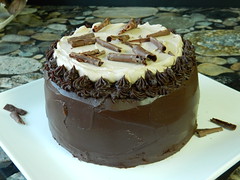 I've made hamantaschen a couple of times before this week's The Baking Bible assignment, having learned about the cookie from my Jewish sister-in-law. It's not a style of cookie that particularly appeals to me--I class it with jam thumbprint cookies and the like. This may or may not have anything to do with my struggles to produce acceptable-looking hamantaschen. Alas, Rose's recipe might taste a little better than the others I've attempted, but I still struggled with the shaping and baking.
I've made hamantaschen a couple of times before this week's The Baking Bible assignment, having learned about the cookie from my Jewish sister-in-law. It's not a style of cookie that particularly appeals to me--I class it with jam thumbprint cookies and the like. This may or may not have anything to do with my struggles to produce acceptable-looking hamantaschen. Alas, Rose's recipe might taste a little better than the others I've attempted, but I still struggled with the shaping and baking.This recipe is a butter cookie made in the food processor. There are the usual amounts of precise details in the recipe, but nonetheless the actual dough is pretty quick to put together. I then skipped the time-consuming step of making a poppyseed filling from scratch (with a side of making apricot levkar to stir into it) in favor of the can of Solo poppyseed filling enhanced with a bit of lemon peel and some apricot jam stirred in. I also made some hamantaschen with just the apricot jam, de-pulped per Rose's instructions for a levkar substitute.
I used a slightly smaller cookie cutter of about 2.5 inches instead of 3, and after overfilling the first batch discovered that a scant teaspoon was plenty of filling--Rose calls for 2 teaspoons for the 3-inch cookie dough rounds. I used the egg glaze to try to glue the cookie sides into the classic tricorne hat shape and chilled the formed cookies before baking, all trying to keep the cookies from unfolding as they bake and letting the filling run out.
My failure rate was down from my last attempt (with the Smitten Kitchen Cookbook recipe, I think), but that's not saying much. Sister-in-law informs me, now that I'm done with my hamantaschen baking, that folding the sides in to almost completely close is a better strategy. That bit about folding the collapsed sides back up while the cookies are hot from the oven? Not so much. Observe the not-so-pretty cookies:

In terms of taste, I think the dough is an improvement over my last attempt (though the memory could be off on that). I was a little over-enthusiastic with the lemon peel in the poppyseed filling, but it was in the acceptable range...if you like lemon. The ones where I also stirred in some mini chocolate chips were better, as the chocolate moderated the poppyseed. (And not much isn't improved with a bit of chocolate.) The apricot ones were not successful--I should have used apricot preserves straight from the jar, not the heated-and-sieved version that was a bit too thin to fill these cookies.
So: not really my sort of cookie, and one where I struggle with the baking technique. I sent most of the batch off with sister-in-law for her "Tickling Tech" teachers' session on Friday morning, where the small crowd seemed to appreciate them. The most appreciated cookies of the batch, though, were another step down the line. Sister-in-law passed along the leftovers to another teacher who gave one each to 6 students as a reward for having quietly lined up before class as instructed. Those students ate them slowly and with great enjoyment while the tardy remainder of their classmates watched from the other side of the door, cookie-less. This seems to have greatly enhanced the hamantaschen.













































